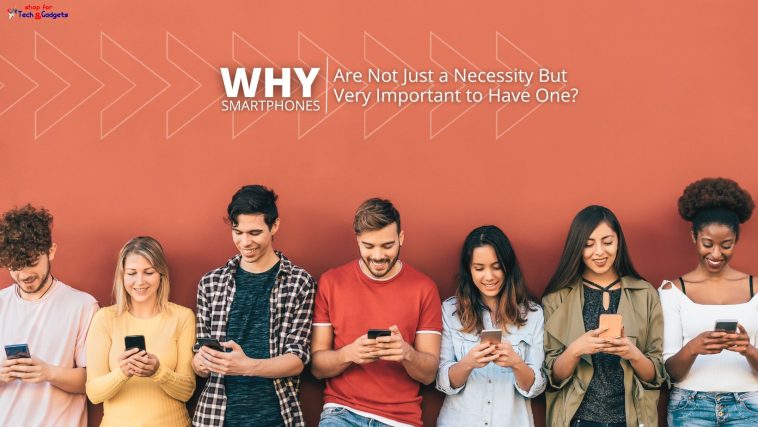Smartphones have become an inseparable part of our daily lives, evolving far beyond their initial purpose of communication. With rapid technological advancements, the way we interact with the world has changed significantly. Long gone are the days of pigeons carrying messages or letters taking weeks to reach their destinations. We have moved from landline telephones to mobile phones, and now, smartphones have revolutionized communication, entertainment, and productivity. But in today’s digital age, how essential is it to own and use a smartphone? Let’s explore its impact on modern life, its benefits, and the challenges that come with it.
The Evolution of Mobile Communication
A few decades ago, mobile phones were considered a luxury. They were bulky, expensive, and primarily used for business purposes. Communication costs were high, making them inaccessible to the average person. However, with technological advancements and increasing competition, mobile phones became affordable, compact, and feature-rich, leading to widespread adoption.
Today, smartphones are not just communication devices but multi-functional tools that help users navigate daily life. With internet connectivity, high-resolution cameras, mobile banking, social media, and productivity apps, smartphones serve as personal assistants, entertainment hubs, and business tools—all in one device. Their significance continues to grow, making them indispensable in both personal and professional spheres.
Why Smartphones Are a Necessity Today
1. Seamless Communication
Smartphones have made global communication instant and effortless. Whether through voice calls, text messages, video calls, or social media, staying connected with family, friends, and colleagues has never been easier. Messaging apps like WhatsApp, Telegram, and Messenger enable real-time communication regardless of distance.
2. Access to Information and Education
Smartphones have turned the internet into an easily accessible knowledge hub. With just a few taps, users can access news, educational resources, online courses, and research materials. Platforms like YouTube, Coursera, and Khan Academy provide free educational content, helping students and professionals enhance their skills. E-books and audiobooks further contribute to learning on the go.
3. Entertainment on the Go
With powerful processors and large displays, smartphones serve as portable entertainment centers. Streaming services like Netflix, YouTube, and Spotify allow users to watch movies, listen to music, and play games from anywhere. Social media platforms also provide endless content, from memes to live events, keeping users engaged.
4. Convenience in Daily Tasks
Smartphones simplify everyday tasks through a wide range of apps. From navigation apps like Google Maps to food delivery services like Uber Eats and DoorDash, everything is available at our fingertips. Mobile banking, online shopping, and digital payment platforms such as Apple Pay, Google Pay, and PayPal have made financial transactions easier and more secure.
5. Emergency and Safety Features
One of the most critical advantages of smartphones is their role in emergencies. In Japan, for example, mobile networks provide real-time earthquake and natural disaster alerts. Many smartphones now come with SOS features that allow users to quickly contact emergency services or share their location with loved ones. Features like medical ID, fall detection, and emergency dialing have saved countless lives.
6. Remote Work and Productivity
The rise of remote work and freelancing has increased reliance on smartphones for professional tasks. With apps like Microsoft Office, Google Workspace, and Zoom, people can work from anywhere. Cloud storage services like Dropbox and Google Drive make it easy to access and share files on the go. Many businesses now operate through smartphones, enabling entrepreneurs to manage their work efficiently.
7. Health and Fitness Tracking
Smartphones contribute significantly to health and wellness. Apps like MyFitnessPal, Strava, and Fitbit track daily activities, workouts, and diet plans. Mental health apps provide guided meditation, therapy sessions, and stress management techniques, helping users maintain a balanced lifestyle.
The Drawbacks of Smartphone Dependency
While smartphones offer numerous benefits, excessive use can lead to potential drawbacks.
1. Addiction and Reduced Productivity
Smartphone addiction is a growing concern, especially among younger users. Social media, gaming, and endless notifications can lead to decreased focus and productivity. Many people spend hours scrolling through their phones, affecting work efficiency and social interactions.
2. Health Concerns
- Eye Strain and Sleep Issues: Prolonged screen exposure can cause digital eye strain, headaches, and disrupted sleep patterns due to blue light emission.
- Radiation Exposure: While there is ongoing debate about the impact of smartphone radiation, some studies suggest prolonged exposure may have potential health risks. Using hands-free options or reducing phone usage near the head is advised.
- Posture Problems: Constant smartphone use can lead to “text neck” syndrome, which causes neck and back pain due to poor posture.
3. Safety Risks While Driving
Using a smartphone while driving is a major cause of accidents. Despite hands-free options, distractions from calls, messages, and navigation apps can increase the risk of road mishaps. Many countries have imposed strict laws to reduce smartphone-related accidents.
4. Privacy and Security Threats
With increased reliance on smartphones, data privacy has become a major concern. Cybercriminals target personal information through phishing, malware, and hacking attempts. Users must take precautions by enabling two-factor authentication, updating security settings, and avoiding suspicious links or apps.
5. Social Disconnect
Ironically, while smartphones connect people digitally, they can also lead to physical and emotional disconnect. Many individuals spend more time on their devices than engaging in face-to-face interactions, leading to weakened personal relationships and social isolation.
The Future of Smartphones: What’s Next?
The smartphone industry continues to evolve, with manufacturers integrating advanced technologies such as:
- Artificial Intelligence (AI): AI-driven features like voice assistants, facial recognition, and smart photography are becoming standard in smartphones.
- 5G Technology: Faster internet speeds and lower latency will enhance connectivity and enable futuristic applications like smart cities and autonomous vehicles.
- Foldable and Wearable Tech: Foldable smartphones and wearable devices like smartwatches are gaining popularity, offering new ways to interact with technology.
- Eco-Friendly Designs: Brands are focusing on sustainable materials and longer-lasting batteries to reduce environmental impact.
With such advancements, smartphones will continue to shape our daily lives, making them even more indispensable in the future.
10 Best Budget-Friendly Smartphones
In today’s digital landscape, owning a smartphone is essential for staying connected, accessing information, and managing daily tasks efficiently. For those seeking budget-friendly options, here are ten smartphones that offer excellent value for their price:
Xiaomi Redmi Note 14 Pro 5G
The Xiaomi Redmi Note 14 Pro 5G offers a balance of performance and affordability, featuring a high-refresh-rate display and a capable processor, making it suitable for both casual users and gamers.
Samsung Galaxy A55
The Samsung Galaxy A55 boasts a sleek design with a super touch display, providing a smooth user experience. It’s a powerful device suitable for everyday use without breaking the bank.
Motorola Moto G55 5G
The Motorola Moto G55 5G provides 5G connectivity and robust performance, ensuring users can enjoy fast internet speeds and smooth multitasking capabilities.
Apple iPhone SE (2022)
Combining Apple’s reliability with modern features, the iPhone SE (2022) offers a balanced performance and 5G connectivity, catering to users seeking a dependable device.
Google Pixel 8A
Featuring a 120Hz OLED screen and seven years of OS and security updates, the Pixel 8A ensures longevity and smooth performance, making it a smart investment for budget-conscious users.
Honor Magic 6 Lite
The Honor Magic 6 Lite offers flagship-like performance with a Snapdragon 8 Gen 2 chipset and 80W fast charging, providing a premium experience at a mid-range price.
Poco X6 Pro
The Poco X6 Pro provides 5G connectivity and robust performance, ensuring users can enjoy fast internet speeds and smooth multitasking capabilities.
Nothing Phone (2A)
The Nothing Phone (2A) offers a balance of performance and affordability, featuring a high-refresh-rate display and a capable processor, making it suitable for both casual users and gamers.
Samsung Galaxy A35 5G
Combining Samsung’s reliability with modern features, the Galaxy A35 5G offers a balanced performance and 5G connectivity, catering to users seeking a dependable device.
TCL 40R 5G
The TCL 40R 5G provides 5G connectivity and robust performance, ensuring users can enjoy fast internet speeds and smooth multitasking capabilities.
These smartphones combine affordability with essential features, ensuring users can stay connected and productive without overspending.
Conclusion
There is no doubt that smartphones have become an essential part of modern life. From communication and education to entertainment and safety, they offer numerous benefits that simplify our daily routines. However, like any technology, responsible usage is crucial to avoid the potential downsides, such as addiction, health risks, and security threats.
As smartphone technology continues to advance, it is up to users to make the most of its benefits while maintaining a balanced and mindful approach to usage. Whether for work, learning, or staying connected, smartphones have undeniably transformed how we live and interact with the world today.




